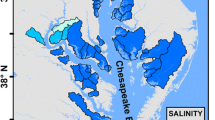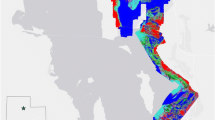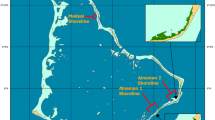Abstract
Non-native Phragmites australis poses an increasing threat to salt marsh eco-systems in the eastern United States. Multiple factors affect P. australis spread, including reduced salinity and nitrogen runoff. Methods for measuring expansion, such as field surveys or geographic information system (GIS) mapping, often require tradeoffs between precision and scope. We combined field work with high-precision global positioning system (GPS) technology and GIS to investigate expansion of 16 P. australis patches at Drakes Island Marsh in Wells, Maine. Our objectives were to: 1) calculate change in patch area, 2) determine whether expansion varied with respect to site-specific variables, and 3) determine whether expansion varied with respect to landscape variables. Significant patch expansion occurred in 1 year, with an 11 % increase in overall coverage. Expansion was negatively related to pore water salinity, with salinity accounting for 25 % of the variation in expansion. Expansion showed an unexpected directionality warranting further investigation, with patches expanding northeastward more so than in other compass directions. Our methodology allowed for measurement of multiple marsh patches and key variables yet captured small-scale changes over only one growing season. This methodology could potentially be a useful tool for studying expansion rates of invasive species in other salt marsh systems.




Similar content being viewed by others
References
Alpert P, Bone E, Holzapfel C (2000) Invasiveness, invasibility and the role of environmental stress in the spread of non-native plants. Perspectives in Plant Ecology, Evolution and Systematics 3:52–66
Artigas F, Pechmann IC (2010) Balloon imagery verification of remotely sensed Phragmites australis in an urban estuary of New Jersey, USA. Landscape and Urban Planning 95:105–112
Bart D (1997) The use of local knowledge in understanding ecological change: a study of salt hay farmers’ knowledge of Phragmites australis invasion. Master’s Thesis, Rutgers University, New Brunswick, New Jersey
Bertness M, Silliman BR, Jefferies R (2004) Salt marshes under siege. American Scientist 92:54–61
Bertness MD, Ewanchuk PJ, Silliman BR (2002) Anthropogenic modification of New England salt marsh landscapes. Proceedings of the National Academy of Sciences 99:1395–1398
Bertness MD, Shumway SW (1993) Competition and facilitation in marsh plants. American Naturalist 142:718
Binkley D, Matson P (1983) Ion exchange resin bag method for assessing forest soil nitrogen availability. Soil Science Society of America Journal 47:1050–1052
Boumans RMJ, Burdick DM, Dionne M (2002) Modeling habitat change in salt marshes after tidal restoration. Restoration Ecology 10:543–555
Bourgeau-Chavez LL, Kowalski KP, Carlson Mazur ML, Scarbrough KA, Powell RB, Brooks CN, Huberty B, Jenkins LK, Banda EC, Galbraith DM, Laubach ZM, Riordan K (2013) Mapping invasive Phragmites australis in the coastal Great Lakes with ALOS PALSAR satellite imagery for decision support. Remote Sensing of the Great Lakes and Other Inland Waters 39:65–77
Burdick DM, Buchsbaum R, Holt E (2001) Variation in soil salinity associated with expansion of Phragmites australis in salt marshes. Environmental and Experimental Botany 46:247–261
Burdick DM, Dionne M, Boumans RM, Short FT (1997) Ecological responses to tidal restorations of two northern New England salt marshes. Wetlands Ecology & Management 4:129–144
Burdick DM, Konisky RA (2003) Determinants of expansion for Phragmites australis, common reed, in natural and impacted coastal marshes. Estuaries 26:407–416
Chambers RM, Meyerson LA, Saltonstall K (1999) Expansion of Phragmites australis into tidal wetlands of North America. Aquatic Botany 64:261–273
Chambers RM, Osgood DT, Bart DJ, Montalto F (2003) Phragmites australis invasion and expansion in tidal wetlands: interactions among salinity, sulfide, and hydrology. Estuaries 26:398–406
Dionne M, Dalton C, Wilhelm H (2006) Site Profile of the Wells National Estuarine Research Reserve. Wells National Estuarine Research Reserve, Wells, p 312
Ewanchuk PJ, Bertness MD (2004) Structure and organization of a northern New England salt marsh plant community. Journal of Ecology 92:72–85
Fitch RA, Theodose T, Dionne M (2009) Relationships among upland development, nitrogen, and plant community composition in a Maine salt marsh. Wetlands 29:1179–1188
Ghioca-Robrecht DM, Johnston CA, Tulbure MG (2008) Assessing the use of multi-season Quickbird imagery for mapping invasive species in a Lake Erie coastal marsh. Wetlands 28:1028–1039
Hellings SE, Gallagher JL (1992) The effects of salinity and flooding on Phragmites australis. Journal of Applied Ecology 29:41–49
Hershner C, Havens KJ (2008) Managing invasive aquatic plants in a changing system: strategic consideration of ecosystem services. Conservation Biology 22:544–550
Holdredge C, Bertness MD (2011) Litter legacy increases the competitive advantage of invasive Phragmites australis in New England wetlands. Biological Invasions 13:423–433
Ishii J, Kadono Y (2002) Factors influencing seed production of Phragmites australis. Aquatic Botany 72:129–141
Jodoin Y, Lavoie C, Villeneuve P, Theriault M, Beaulieu J, Belzile F (2008) Highways as corridors and habitats for the invasive common reed Phragmites australis in Quebec, Canada. Journal of Applied Ecology 45:459–466
Kettenring KM, Whigham DF (2009) Seed viability and seed dormancy of non-native Phragmites australis in suburbanized and forested watersheds of the Chesapeake Bay, USA. Aquatic Botany 91:199–204
Kettenring KM, McCormick MK, Baron HM, Whigham DF (2010) Phragmites australis (common reed) invasion in the Rhode River subestuary of the Chesapeake Bay: Disentangling the effects of foliar nutrients, genetic diversity, patch size, and seed viability. Estuaries and Coasts 33:118–126
Kettenring KM, Mock KE (2012) Genetic diversity, reproductive mode, and dispersal differ between the cryptic invader, Phragmites australis, and its native conspecific. Biological Invasions 14:2489–2504
Konisky RA (2003) Spatial modeling and visualization of habitat response to hydrologic restoration in New England salt marshes. Dissertation, University of New Hampshire
Laba M, Downs R, Smith S, Welsh S, Neider C, White S, Richmond M, Philpot W, Baveye P (2008) Mapping invasive wetland plants in the Hudson River National Estuarine Research Reserve using quickbird satellite imagery. Remote Sensing of Environment 112:286–300
Lambert AM, Dudley TL, Saltonstall K (2010) Ecology and impacts of the large-statured invasive grasses Arundo donax and Phragmites australis in North America. Invasive Plant Science and Management 3:489–494
League MT, Colbert EP, Seliskar DM, Gallagher JL (2006) Rhizome growth dynamics of native and exotic haplotypes of Phragmites australis (common reed). Estuaries and Coasts 29:269–276
Lelong B, Lavoie C, Jodoin Y, Belzile F (2007) Expansion pathways of the exotic common reed (Phragmites australis): a historical and genetic analysis. Diversity & Distributions 13:430–437
Maheu-Giroux M, de Blois S (2005) Mapping the invasive species Phragmites australis in linear wetland corridors. Aquatic Botany 83:310–320
McCormick MK, Kettenring KM, Baron HM, Whigham DF (2010) Spread of invasive Phragmites australis in estuaries with differing degrees of development: genetic patterns, allee effects and interpretation. Journal of Ecology 98:1369–1378
McKee J, Richards A (1996) Variation in seed production and germinability in common reed (Phragmites australis) in Britain and France with respect to climate. New Phytologist 133:233–243
Medeiros DL, White DS, Howes BL (2013) Replacement of Phragmites australis by Spartina alterniflora: the role of competition and salinity. Wetlands 33:421–430
Minchinton T, Bertness M (2003) Disturbance-mediated competition and the spread of Phragmites australis in a coastal marsh. Ecological Applications 13:1400–1416
Minchinton TE, Simpson JC, Bertness MD (2006) Mechanisms of exclusion of native coastal marsh plants by an invasive grass. Journal of Ecology 94:342–354
Moore GE, Burdick DM, Peter CR, Keirstead DR (2012) Belowground biomass of Phragmites australis in coastal marshes. Northeastern Naturalist 19:611–626
Pengra BW, Johnston CA, Loveland TR (2007) Mapping an invasive plant, Phragmites australis, in coastal wetlands using the EO-1 Hyperion hyperspectral sensor. Remote Sensing of Environment 108:74–81
Philipp KR, Field RT (2005) Phragmites australis expansion in Delaware Bay salt marshes. Ecological Engineering 25:275–291
Poulin B, Davranche A, Lefebvre G (2010) Ecological assessment of Phragmites australis wetlands using multi-season SPOT-5 scenes. Remote Sensing of Environment 114:1602–1609
Roman CT, James-Pirri MJ, Heltshe JF (2001) Monitoring salt-marsh vegetation. Technical Report, Long-term Coastal Ecosystem Monitoring Program, Cape Cod National Seashore, Wellfleet, Massachusetts
Roman CT, Raposa KB, Adamowicz SC, James-Pirri MJ, Catena JG (2002) Quantifying vegetation and nekton response to tidal restoration of a New England salt marsh. Restoration Ecology 10:450–460
Rooth JE, Stevenson JC (2000) Sediment deposition patterns in Phragmites australis communities: implications for coastal areas threatened by rising sea level. Wetlands Ecology and Management 8:173–183
Saltonstall K (2002) Cryptic invasion by a non-native genotype of the common reed, Phragmites australis, into North America. Proceedings of the National Academy of Sciences of the United States of America 99:2445–2449
Silliman BR, Bertness MD (2004) Shoreline development drives invasion of Phragmites australis and the loss of plant diversity on New England salt marshes. Conservation Biology 18:1424–1434
Vasquez E, Glenn E, Brown J, Guntenspergen G, Nelson S (2005) Salt tolerance underlies the cryptic invasion of North American salt marshes by an introduced haplotype of the common reed Phragmites australis (Poaceae). Marine Ecology Progress Series 298:1–8
Acknowledgments
This study was conducted under the direction of the late Dr. Michele Dionne, former research director at the Wells National Estuarine Research Reserve, Wells, ME. We thank Tin Smith and the interns at the Wells NERR as well as USM graduate student Michael Esty for assistance with field work. We thank Dr. Karen Wilson for advice on experimental design, Dr. Jeff Walker for help with statistics, and USM graduate student Abby Pearson for help assembling resin bags. Thanks as well to Sue Bickford at the Wells NERR, Dr. Vinton Valentine, Dr. Matthew Bampton, Abraham Dailey and Andy Smith-Petersen for GIS help and encouragement. Finally, we extend particular thanks to the two anonymous reviewers whose well-considered comments and suggestions significantly improved this manuscript. Funding was provided by the Maine ScienceCorps Program and the National Science Foundation (Grant #DGE-0440560) as well as the University of Southern Maine Department of Biological Sciences. Field work was conducted on land managed by the Wells NERR and the Rachel Carson National Wildlife Refuge under a U.S. Department of the Interior Fish and Wildlife special use permit (#53553-2009-13).
Author information
Authors and Affiliations
Corresponding author
Additional information
Michele L. Dionne is deceased July 4, 2012.
Rights and permissions
About this article
Cite this article
Fussell, S.B., Dionne, M.L. & Theodose, T.A. Expansion Rates of Phragmites australis Patches in a Partially Restored Maine Salt Marsh. Wetlands 35, 557–565 (2015). https://doi.org/10.1007/s13157-015-0645-3
Received:
Accepted:
Published:
Issue Date:
DOI: https://doi.org/10.1007/s13157-015-0645-3




